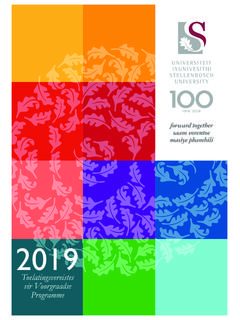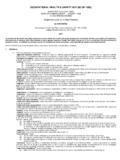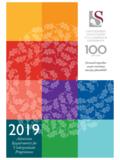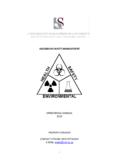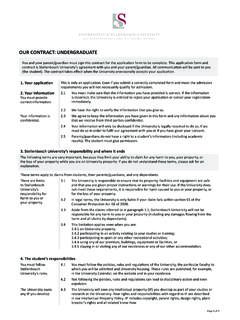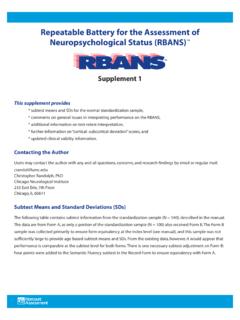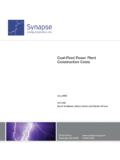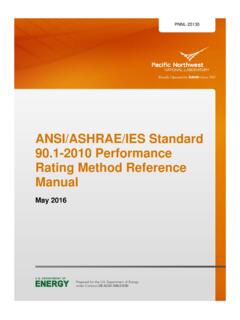Transcription of Guide for Writing Technical Reports - Stellenbosch University
1 Guide for Writing Technical Reports AH Basson & TW von Backstr m Third Edition 2007. Guide for Writing Technical Reports For Final Year Projects and Postgraduate Studies in Engineering AH Basson & TW von Backstr m Department of Mechanical and Mechatronic Engineering Stellenbosch University Third Edition 2007. 2007 Stellenbosch University ABSTRACT. This Guide provides guidelines to engineering students for Writing Technical Reports (for example on vacation work, experiments, design projects and final year projects), theses and dissertations. It provides an extensive discussion of the contents of the various main elements of a Technical report and gives the recommended format. Some of the important elements of a good microstructure and style, and practical guidelines for the compilation of a Technical report , are also provided. The Guide concludes with a checklist that can be used by students to eliminate general mistakes.
2 The appendices provide guidelines for the content of Reports on experiments, designs, and calculations, as well as guidelines for thesis proposals, the use of SI units and the use of the Harvard referencing method. i Dedicated to future mechanical and mechatronic engineers ii ACKNOWLEDGEMENTS. The authors thank Thomas Harms, Nico Theron and Mimi Westdyk for helping to improve the Guide and Anneke Louw for the layout and formatting of the first edition. The third edition includes an appendix on plagiarism and the use of the alphabetic referencing style that was contributed by the Language Centre at Stellenbosch University . iii TABLE OF CONTENTS. Page List of Tables ..vii 1. Introduction ..1. 2. The Process for Compiling a Technical report ..1. 3. External Sequence of Main Sections ..2. Cover Title Acknowledgements ..5. Table of Contents ..5. List of Tables and List of Introduction ..6. Central Chapters.
3 7. Conclusions ..7. Tables and Appendices ..9. References ..9. The alphabetical The numerical system ..10. Bibliography ..10. 4. Microstructure ..10. 5. 6. Font, Page Numbering and Headings ..13. Equations ..14. 7. A Checklist ..15. iv 8. 9. References ..17. Appendix A: Guidelines for the Documentation of Principles ..19. Introduction or Introductory Experimental Setup ..19. Experimental Procedure ..20. Measured Processed Results ..20. Conclusions ..20. Appendix B: Guidelines for the Documentation of Designs ..21. Purpose and Principles ..21. Assignment and Specification ..21. Concept Development ..21. Analysis and/or Testing of Performance ..22. Technical Definition of Product ..22. Appendix C: Guidelines for the Documentation of Derivations and Calculations23. Introduction ..23. Sample Calculations ..23. Layout of Equations and Numerical Appendix D: Guidelines for Thesis Planning ..25. Front Introduction.
4 26. Problem Statement, Objectives or Hypothesis ..26. Motivation, Background and Literature v Research Planning ..27. Conclusion ..28. Appendix E: Guidelines for the Use of SI Units ..29. Introduction ..29. Writing Style ..29. Basic Units, Prefixes and Derived Units ..29. Decimal Point or Comma? ..30. Appendix F: Referencing and What is meant by referencing?..31. When should you give a reference?..31. When is a reference not needed? ..31. Why should you give references?..31. How do you reference?..32. The Harvard-method of referencing ..32. Steps for Examples of references according to the Harvard-method ..34. What is plagiarism? ..36. vi LIST OF TABLES. Page Table 1: Acceptable Page Layouts ..13. Table 2: Acceptable Letter Sizes ..13. vii 1. INTRODUCTION. The majority of engineering tasks include the Writing of Technical Reports , even if the main objective is much more extensive. Since Technical Reports and papers are used to summarise information in a way that is easily accessible, they should be as concise, accurate and complete as possible, and be aimed at a specific group of readers.
5 The immediate objective of this Guide is to help students following bachelor's, master's and doctoral programmes in engineering to approach report Writing effectively during their studies and to present the Reports in a professional format. A further objective is to prepare students for the Writing of Technical Reports and papers in engineering practice. The format described in this Guide is the prescribed format for student Reports in the Department of Mechanical and Mechatronic Engineering at Stellenbosch University . In this document, the term " Reports " is considered to include theses and dissertations. The emphasis in this Guide falls on the prescribed format for a Technical report , but a few hints on paragraph structure and Writing method are also given. Although there are a number of standard formats, such as those of Beer and McMurrey (1997), Campbell and Ballou (1994) and Blicq (1987), only one format is described in this Guide .
6 Readers who would like to obtain more information on the Writing of Technical Reports are referred to the books by Weisman (1974), Pakin (1982), Michaelson (1984), Pauley and Riordan (1985), Rathbone (1988) and Van Emden (1989). There is an excellent book on style written by Strunk and White (1979). The format of this Guide follows its own prescriptions as far as possible to serve as an example. 2. THE PROCESS FOR COMPILING A Technical report . As with any Writing , one of the first questions that must be asked in the planning process is "Who is the target reader?" In engineering practice, the reader can be a client, a colleague, a manager or a junior. In academic Writing , the target reader is usually the examiner. The examiner is normally independent and was not involved in the initiation or executing of the work being reported. The author must therefore ensure that sufficient background and detail is given to convince the examiner.
7 When academic Writing is aimed at an examination process, the outcomes or assessment criteria must be thoroughly accounted for in the planning of the 1. Writing . It will be of great benefit to the author to study the relevant assessment criteria. The process of Writing a Technical report begins with planning the work on which the report is based. Even at this early stage, the task can be broken down into elements which are likely to become the chapters or sections of the report . The final sequence of the chapters and sections will usually not correspond with the order in which the work was done, but will be determined by the desired structure of the report . The general rule is to begin Writing the sections of the report as soon as possible. The table of contents should be drafted very early in the process of Writing the report since the table of contents provides a good overview of the entire document and, while the report is being written, provides an indication of which sections still need to be done.
8 Regardless of the order of the report , a chapter or an appendix (with tables and figures) should be written as soon as that part of the work has been completed, for example when some apparatus has been developed or set up, a section of theory has been derived, a computer program has been written, or a set of readings has been taken. It is also a good idea to give the written work to a fellow student or a supervisor as early as possible to criticize constructively. Some sections written as appendices in the early phases will remain appendices, while others will later be included in the main text and some will not be included in the final report . It is important to keep in mind that report Writing is an integral part of the thought process: it helps to define and order ideas and to derive well-considered conclusions so that further planning of the work can be undertaken. 3. EXTERNAL STRUCTURE. Professional Technical Reports are characterised by a scientific approach, typical external structure and formal style.
9 This chapter discusses the recommended external structure and the way in which the scientific approach is reflected in this structure. Sequence of Main Sections The elements of a Technical report , in their prescribed sequence, are: Cover page Title page Abstract Dedication Acknowledgements Table of contents List of tables 2. List of figures Nomenclature Introductory chapters(s). Central chapters Conclusions Tables*. Figures*. Appendices References**. Bibliography * Alternatively, the tables and figures may be placed in the main text instead of at the end (both approaches may not be used in the same report ). If a figure or table is referred to on a number of pages, it will limit paging around in the text if it appears after the main text. The main text should only refer directly to figures or tables in the appendices in exceptional cases. In a long report , the tables and figures relating to each chapter may appear directly after the text in the chapter, as long as they are numbered as , , etc.
10 Take note that only one type of placing should be used consistently throughout the report . ** In a report with few, short or no appendices, the list of references can follow immediately after the conclusion. References are more easily located in a long report when they are placed right at the end of the report . When there are references in the appendices, it is preferable that all the references appear at the end of the report , otherwise each appendix should have its own list of references. The external structure does not only relate to the sequence of the elements, but also to the relationships between the elements and the importance and size of each. It is important that the emphasis be placed on the central chapters. A report is like a story: it must have a beginning, a middle and an end, but the middle is the actual story. The introduction must not be too long, and the central chapters must not be overpowered by the appendices.
